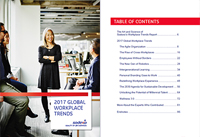A collaborative addition to the workforce
Interview with Bob Doyle, Director of Communications, Association for Advancing Automation (A3).
 Sodexo 2017 Global Workplace Trends Report is hot off the press with ten major trends that will impact our workplace today and in the years to come. Today we sat down with Bob Doyle, Director of Communications at Association for Advancing Automation to talk about how robotics can pave the way for humans to take on more exciting roles in the workplace.
Sodexo 2017 Global Workplace Trends Report is hot off the press with ten major trends that will impact our workplace today and in the years to come. Today we sat down with Bob Doyle, Director of Communications at Association for Advancing Automation to talk about how robotics can pave the way for humans to take on more exciting roles in the workplace.
There is a lot of talk about “collaborative robotics” in the workplace. What exactly does that term encompass?
Bob Doyle: Collaborative robotics first came onto the market a few years ago. It basically refers to robots or technology that can work side-by-side with humans – a big development compared to traditional industrial robotics. Think about an automotive line where these big robots are moving fast and welding parts together. Fences around these robots are often mandatory to safely separate them from human workers. The notion of collaborative robots means that with certain newer robots, you can take the fence away. But there are tradeoffs. In order to work safely around humans, they are slower. At the same time, they also bring in lots of new opportunities – they are much smaller, they don’t take up as much space on the manufacturing floor, they are easier to program and implement, they open up a whole new wave of opportunities – especially for smaller or medium-sized companies that have never used robotics.
How does the development of intelligent machines affect the workplace?
B.D.: Today, autonomous robots and machines can move around warehouses and, for example, take product from a shelf and bring it to someone. In the healthcare sector, robots are roaming hospital hallways delivering pharmaceuticals, food and bedding and allowing nurses to spend more time with patients rather than spending time moving things around. In the hospitality industry, Savioke’s robot, Relay, is now the newest employee at certain hotels. Imagine that you get to your hotel room late at night, and you forgot to pack a toothbrush. Rather than someone having to leave the front desk and run it up to you, they can now have the Relay robot to deliver the item directly to your room.
What would you say to people who are afraid that artificial intelligence will one day replace human intelligence?
B.D.: The words “artificial intelligence” are often thrown around a lot without really defining exactly what that means. I think the general media talks about artificial intelligence as if machines will soon start thinking on their own and start making decisions and that is definitely not the case in today’s workplace. Not yet, and not in the foreseeable future either. Yes, there is amazing technology out today, but robots are still a long way away from actually having some sort of intelligence that could make them smarter than a human.
Robots and automation are definitely allowing companies to be more productive, develop products that are more innovative, of higher quality and faster. That said, this notion that robots are taking jobs away is untrue. What we actually see is that they augment and create jobs. They allow people to work in better jobs that utilize their brain rather than these dull, dirty and dangerous jobs.
Can you discuss some of the barriers or obstacles that need to be addressed?
B.D.: There are still a lot of challenges in the robot industry that are perhaps not as well known. For example, the ability to do something a human can do so easily with their hands is very difficult to create in the robot industry. If a robot handles like-type products or if there is a repetitive task, then yes, it can easily be programed. But when you have a container of loose products, it’s still hard for a robot to figure out which product it wants and how to pick up that particular product. It’s getting a lot better but it’s still not like a human hand that can just go in and see a product and move it around.
What about on the wearable technology front? Are there innovations that engage people in a more individual way?
B.D.: There is a lot of pretty amazing stuff coming out of this area. In healthcare, a company has created a “robot” suit, which allowed a paraplegic person to walk again. In the military, there has been some research creating a type of suit to carry heavier loads without tiring. In the workplace, companies are developing a type of robotic device that provides support for manual workers. Say you’re a worker who stands all day drilling holes overhead into a ceiling. It’s a tiring activity. But this new invention provides support, allowing them to tire less quickly, making the job much better for them.
Any predictions for the future of robotics?
B.D.: A “helper” type robot for the home is something that people have been dreaming about for 50 years. A robot that could help a person get out of bed, put together a meal, help out with cleaning or allow the elderly to stay in their homes rather than be put into care facilities. But in all the robotics research, which has been going on for so long, the most difficult environment for a robot is in the home. People watch movies and think that we’re pretty close to a robot working amongst us in the home but there has really only been one successful home robot so far – the Roomba vacuum cleaner! But there is definitely interest and research going into this area so someday in the future there will be some type of home robot that can do these different tasks. But it’s a long way out there.


